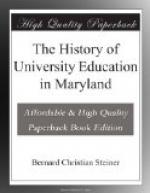Besides this institution there was no successful attempt in Maryland to found a college for female education, until the Woman’s College of Baltimore was chartered in 1884.[52] It was founded by the Methodist Episcopal Church, in honor of the centenary of its organized existence in this country, and is “denominational but not sectarian.” For it beautiful buildings, adjoining the First Methodist Church, have been erected on St. Paul Street. Much of the money for its endowment was given by the present President, the Rev. J.F. Goucher, D.D., and, largely through his influence, was it able to open its doors to students on September 13, 1888. It has determined, very sensibly, to grant no degrees, save to those thoroughly fitted to receive them, and so has had no graduates up to the present. Its growth under the care of W.H. Hopkins, Ph.D., its first President, was great in numbers and endowment and the prospects are now fair for this Baltimore Woman’s College taking high rank among similar institutions.
CONCLUSION.
To a superficial observer from a distance, it sometimes seems as if University education in Maryland began with the foundation of the Johns Hopkins University, a sketch of which follows from the pen of its honored President. Our study into the history of education in the State, however, has shown us that Maryland, instead of being one of the latest of the United States to conceive the University idea, was, in fact, one of the very earliest, and that her institutions have a history of which they need not be ashamed; though their work has not been so widely known as some others and though the bright promise of morning, in many cases, has not been followed by the full development of noontide.
The patient labors of William Smith, of Hector Humphreys, of Francis Asbury, of John Dubois, and of many others, have been far from lost. Wherein they failed, they gained valuable experience for their successors, and wherein they succeeded, they helped to instil “into the minds and hearts of the citizens, the principles of science and good morals.”
FOOTNOTES:
[Footnote 1: Md. Archives; Assembly Proceedings, 1666-1676, pp. 262-264.]
[Footnote 2: Scharf, Hist. of Md., II, p. 510.]
[Footnote 3: Sharpe, Correspondence, Vol. II, pp. 523-5 and 545.]
[Footnote 4: Scharf, Hist, of Md., II, p.511.]
[Footnote 5: Eddis, Letters from Maryland, 1769-1776.]
[Footnote 6: MS. sketch of Prof. Rowland Watts.]
[Footnote 7: Act of 1784, ch. 37.]
[Footnote 8: Act of 1805, ch. 85. The appropriation had already been diminished by Act of 1798, ch. 107.]
[Footnote 9: Centennial of St. John’s. Address of P.R. Voorhees, Esq.]
[Footnote 10: Resolutions of 1832, No. 41.]




